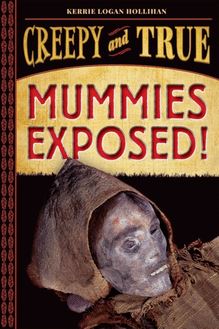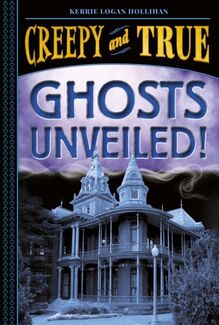Mummies Exposed! , livre ebook
168
pages
English
Ebooks
2019
Vous pourrez modifier la taille du texte de cet ouvrage
Obtenez un accès à la bibliothèque pour le consulter en ligne En savoir plus
Découvre YouScribe en t'inscrivant gratuitement
Découvre YouScribe en t'inscrivant gratuitement
168
pages
English
Ebooks
2019
Vous pourrez modifier la taille du texte de cet ouvrage
Obtenez un accès à la bibliothèque pour le consulter en ligne En savoir plus
Publié par
Date de parution
07 mai 2019
Nombre de lectures
2
EAN13
9781683353751
Langue
English
Poids de l'ouvrage
22 Mo
Publié par
Date de parution
07 mai 2019
Nombre de lectures
2
EAN13
9781683353751
Langue
English
Poids de l'ouvrage
22 Mo
To young readers who ask questions and the grownups who help them find answers
Library of Congress Cataloging-in-Publication Data
Names: Hollihan, Kerrie Logan, author.
Title: Mummies exposed! / by Kerrie Logan Hollihan.
Description: New York: Abrams Books for Young Readers, 2019. | Series: Creepy and true; #1 | Includes bibliographical references and index.
Identifiers: LCCN 2018014310 | ISBN 9781419731679 (hardcovert) | ISBN 978-1-68335-375-1 (eISBN)
Subjects: LCSH: Mummies-Juvenile literature.
Classification: LCC GN293 .H65 2019 | DDC 393/.3-dc23
Text copyright 2019 Kerrie Logan Hollihan
Book design by Becky James
For picture credits, see this page .
Published in 2019 by Abrams Books for Young Readers, an imprint of ABRAMS. All rights reserved. No portion of this book may be reproduced, stored in a retrieval system, or transmitted in any form or by any means, mechanical, electronic, photocopying, recording, or otherwise, without written permission from the publisher.
Abrams Books for Young Readers are available at special discounts when purchased in quantity for premiums and promotions as well as fundraising or educational use. Special editions can also be created to specification. For details, contact specialsales@abramsbooks.com or the address below.
Abrams and Creepy and True are registered trademarks of Harry N. Abrams, Inc.
ABRAMS The Art of Books 195 Broadway, New York, NY 10007 abramsbooks.com
When most people think of a mummy, they think of a body wrapped again and again in cloth, like this Egyptian mummy of a youth (80-100 AD ). However, there are many other kinds of mummies.
INTRODUCTION
The invitation read something like this:
You are cordially invited to attend the Unwrapping of a Mummy
Thursday, May 7, 1908
The Hall of Chemistry
Manchester University, England
Five hundred people-scholars and ordinary men and women-crowded into that lecture hall to watch and learn from Margaret Murray, an English archaeologist. It was the first time a woman had unrolled a mummy in front of a crowd, and her candidate was a doozy. Khnum-Nakht was one of two brothers she studied. He had lived and died during Egypt s Middle Kingdom days about four thousand years ago. A report said:
Khnumu Nekht [as Murray spelled it] was bared of his wrappings and brought once more to the light of day . . . Near the body the linen sheets had rotted, and they fell to pieces at a touch. The bones, however, were more or less perfect. There were traces of flesh on them. It was on the whole a gruesome business, and one or two people left early.
Those one or two, and others perhaps, felt in their bones that Margaret Murray was working on a human being who had once been alive. They understood that Khnum-Nakht had laughed and loved, enjoyed family meals, hung out with friends, celebrated holidays, had stomach aches, and knew fear and joy . . . exactly like them. Exactly like you.
Archaeology, the study of ancient history, was a brand-new field in 1908. Before that, Murray scoffed, it was merely the pastime of . . . the amateur who amused himself by adding beautiful specimens to his collection of ancient art.
Murray was right. For centuries, wealthy Europeans had ventured to Egypt, coming home with mummy souvenirs to show off. And more. Artists ground mummy parts for paint to create a special tint called mummy brown. Along with rags of all sorts, mummies went to mills to be crushed and turned into paper. Doctors prescribed powdered mummy medicine for their patients aches and pains.
Archeologist Margaret Murray (at table) during a public lecture in 1908. She was likely the first woman to unwrap a mummy.
Powdered mummy? Blech! But doctors had done so for ages, possibly due to a mix-up in someone s dictionary. M m is the old Persian word for a sticky wax. It s a natural product found in oil sands and pitch lakes.
M m moved into other languages, and mumia became a term for bitumen, that smelly, gooey stuff used in asphalt driveways and parking lots. Bitumen, aka mumia , also served as a drug to heal all kinds of ancient ailments, from rashes to toothaches to broken bones.
Unlike mummies, languages are flexible. When folks laid eyes on Egypt s mummies, the bodies black coating looked like bitumen, like mumia . (Sometimes it was bitumen; other times, it was not.) It wasn t much of a stretch to call one of these wrapped-up bodies a mummy. Over hundreds of years, people started to believe that mummy wrappings and mummies themselves were powerful medicine. This belief stuck with us into the early 1900s.
Then there s the mummy s curse, another belief that s stuck around. If you ve read about history s best-known mummy, King Tutankhamun (Tut) of ancient Egypt, then you might know about the curse. Within six years of Tut s discovery in 1922, at least ten people linked to the mummy died. The very first was Lord Carnarvon, the English earl who bankrolled the project to find Tut s tomb. He died of an infected mosquito bite even before he cast eyes on the mummy.
Had eager archaeologists insulted the boy king s spirit? Newspapers ran stories about King Tut s curse, and many believed in it for years. Some still do.
When Margaret Murray died in 1963, she was one hundred years old. She saw plenty of change in her life, as humans invented and used telephones, televisions, X-ray machines, cars, and airplanes. People were dreaming of sending humans to the Moon.
Today we text on our phones, use robots for surgery, and talk about sending ourselves to Mars. Time moves on and knowledge multiplies. It s the same with archaeology. When Murray was a girl, archaeologists didn t have modern tools such as X-ray imaging, carbon dating, and DNA sampling. Since then, all these techniques have helped us to flesh out the lives of mummies.
Howard Carter and an Egyptian workman examine King Tut s third and innermost coffin of gold, which sits inside the second coffin case.
Today in the United States, archaeology is but one branch of a much bigger field of study called anthropology. It s likely that if Margaret Murray were at work today, she d call herself an anthropologist.
Anthropos is a Greek root word meaning human. The suffix ology means study.
So there you have it. Anthropology is the study of human beings and their cultures-how we live our lives-across time-from prehistoric days to the present-and across space-all around our world.
Mummies are our very best link to the past. Studying mummies is an anthropologist s dream.
Stories about King Tutankhamun abound in books and other media. No doubt about it; King Tut is Number One. But in this book, you ll meet other, equally fascinating mummies-how they turned up and the tales they tell.
Some you might know, but others will be total strangers. Some were men, others were women, and still others, kids. Some were upper crust and others, ordinary folks. Two lived and died in the past century, and the rest, from hundreds to many thousands of years ago. They turned up in Egypt, China, Central Asia, Russia, Denmark, England, Ireland, Argentina, Chile, and Peru.
But every one had a body that survived the grave, one way or another.
King Tut s glorious shoulder-length mask of gold was a crowd favorite wherever it went on tour.
FACTLET
BODY BREAKDOWN
TO UNDERSTAND WHY mummification works, it s useful to know what happens after a person or animal dies.
ALL OF THESE HAPPEN, BUT NOT ALL AT ONCE:
The heart stops beating.
Blood stops flowing and begins to thicken- livor mortis .
The bowels and bladder empty themselves.
Body temperature drops, a process called algor mortis .
The muscles stiffen. Rigor mortis sets in.
Starved of blood oxygen, cells die.
The skin turns blue-green.
LEFT TO THE OPEN AIR AND THE WORK OF NATURE, THE PROCESS CONTINUES:
Decaying tissues excrete enzymes that encourage bacteria and fungi to grow.
Bacteria produce stinky chemicals called putrescine and cadaverine, explaining why cadavers smell putrid.
Sulphur-based compounds add to the stench. Think spoiled meat mixed with rotten eggs.
Gases from these byproducts fill the body until it bursts.
Soft tissues-organs and skin-disintegrate or are eaten by insects and animals attracted by the foul smell.
Sometime between fifty days and one year after death, the body enters a state of dry decay. Only hair and bones remain. In time, microorganisms will eat the hair.
Keep in mind that the warmer the temperature, the more quickly a body decomposes.
And to debunk one long-lived myth: Hair, beards, and nails do not grow after death. They might appear to, but in fact, the body shrinks. Makes sense, right?
FACTLET
AS THE AUTHOR FINISHED this book in 2018, newspapers reported a new discovery. Margaret Murray had noted that the skulls of the mummy brothers looked very different. Genetic tests showed that the brothers whom Murray unwrapped had different fathers. As you shall discover, there s always something new to learn about old stuff!
CHAPTER ONE
WHAT S BEHIND CURTAIN NUMBER ONE?
In 1988, Victor Mair, an American professor of Chinese language and literature, led a tour to western China. The group was visiting a museum in the city of r mchi, a remote place on an ancient trading trail known as the Silk Road.
The professor and his entourage were checking out displays when he caught a glimpse of a dimly lit gallery partly hidden by a drape. He ventured in, and what he saw changed his life.
Three mummies, looking as though they were sleeping, were laid out in this quiet room. The mummies, a man, a woman, and a baby, were all dressed in bright clothes made of wool and leather. The man and woman had shared a grave, and the baby had not been far off. The preservation was so incredible that at first, the professor thought they were made of wax.
Ur-David, or Ch rch n Man, who died about 1000 BCE , dried in a desert grave in the Tarim Basin in Central Asia.
But when Mair stepped in for a cl


